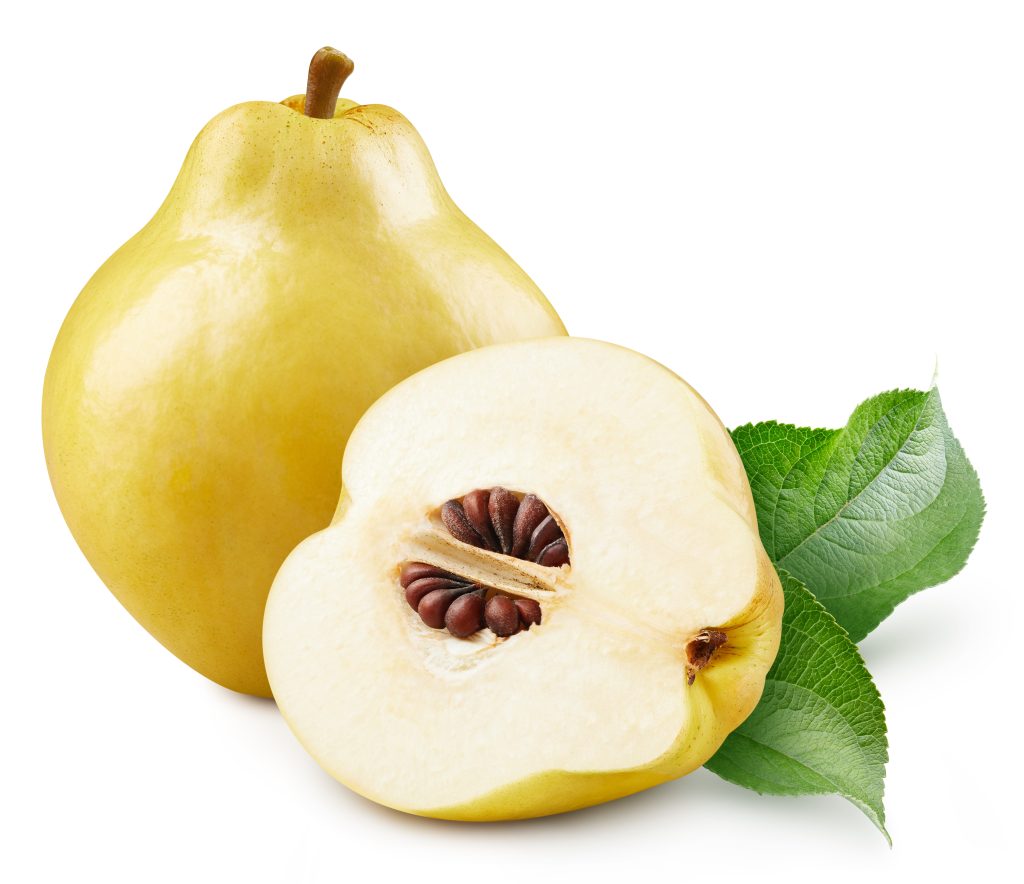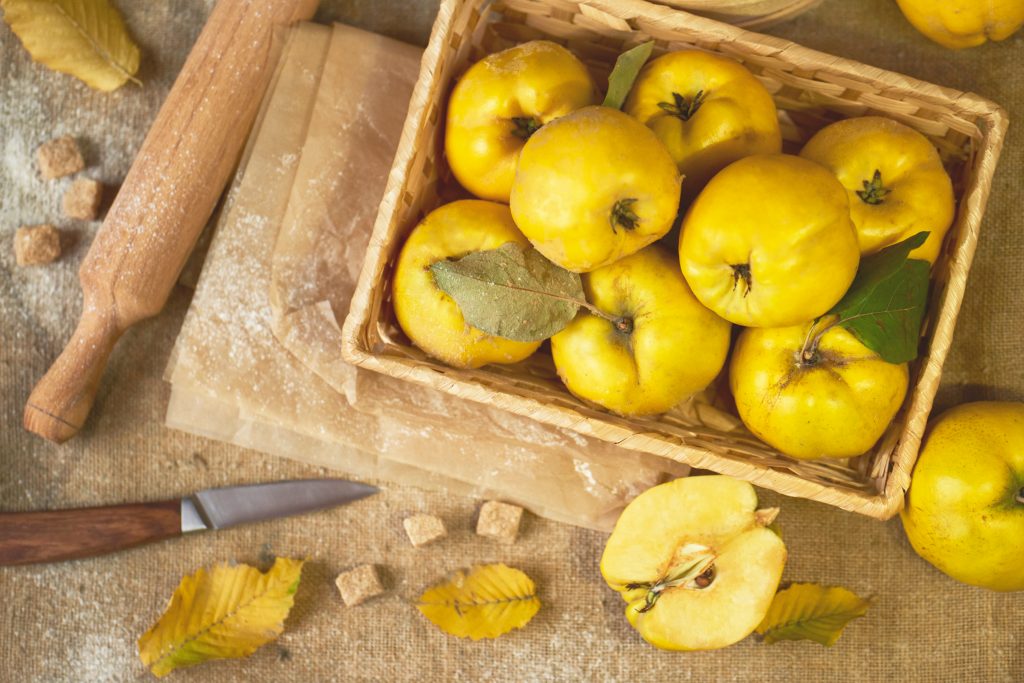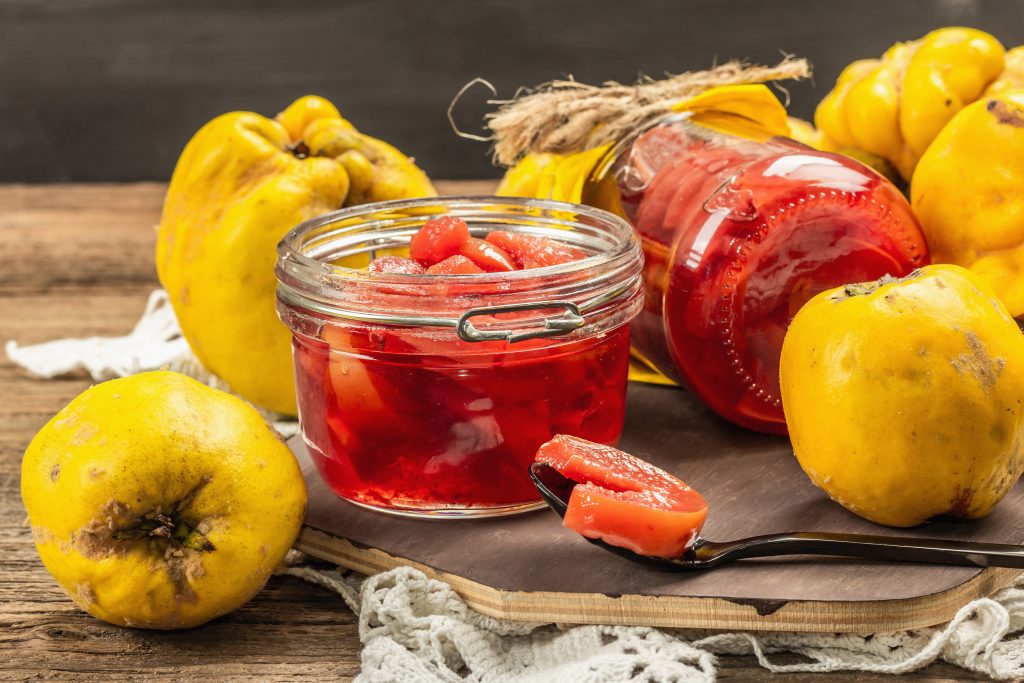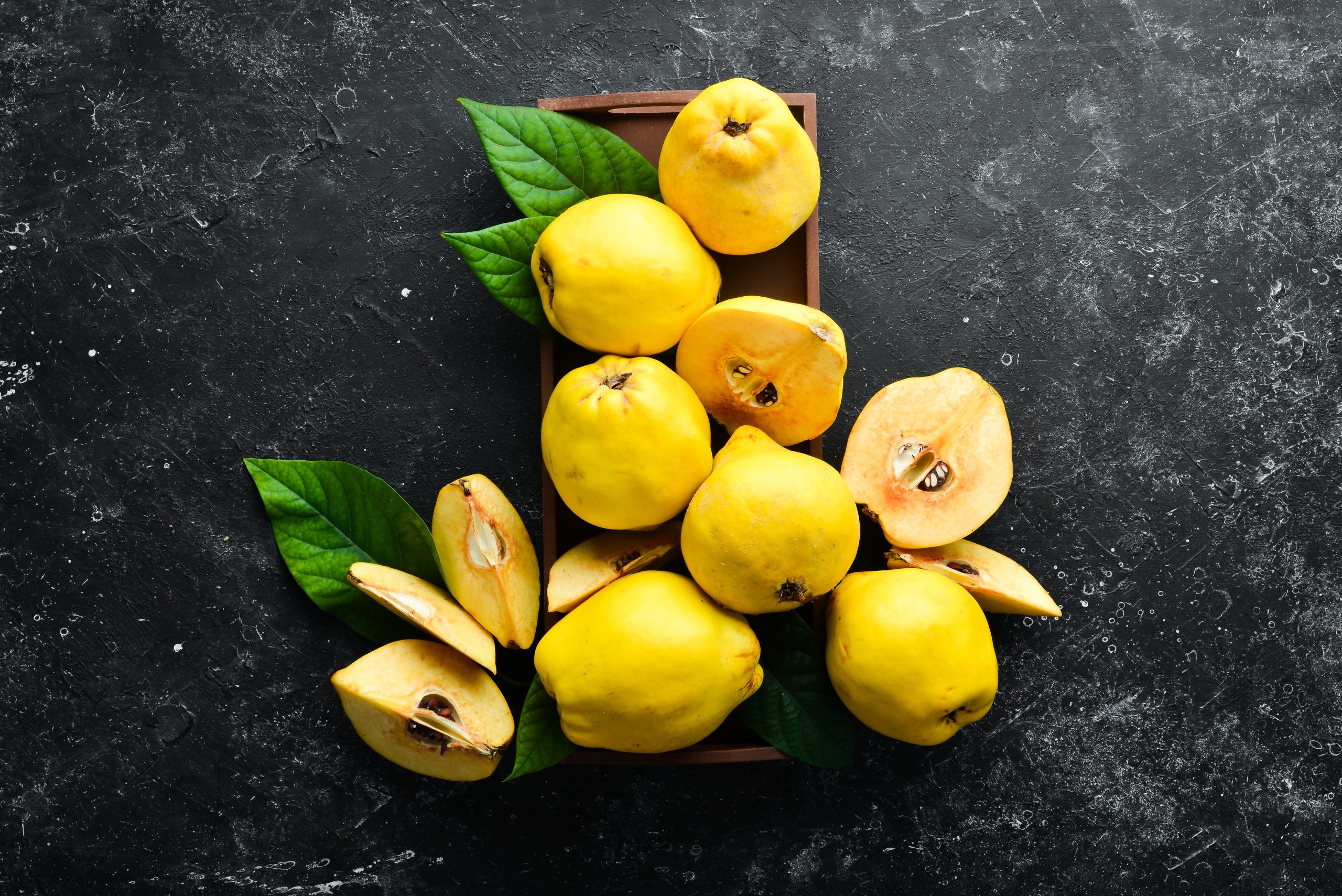Quinces are a wonderfully sour pome fruit that are native to the Mediterranean. While they can be consumed raw right off the branch of a quince tree, most people prefer to use them in jams and other types of fruit preserves due to their high levels of natural pectin.
Table of Contents
What is a Quince?
Quince (Cydonia oblonga) is a pear-shaped pome fruit that is part of the rose family Rosaceae. Unsurprisingly, this subtribe also comprises pears and apples.
It is pronounced as “kwins” (/ˈkwɪns/;) in American English.
Quince can grow in many climates and soils, but many enthusiasts swear the best, sweetest quince is grown in areas of warmer temperatures. According to the University of California, the quince is natively grown in Iran, Turkey, Greece, and the Crimean Peninsula.
A quince visually resembles a large, yellowish-green pear with a slightly irregular shape. The fruit’s tough skin has a rugged, woody texture. The fruit’s flesh is usually pale yellow and dense and filled with seeds – so it looks very similar to the interior of an apple. When cooked, the flesh develops into a beautiful pink color, and its taste becomes sweet and soft.
Quince trees are relatively small trees, typically growing to about 10-15 feet tall, and they produce beautiful white or pink flowers in the spring. The fruit typically ripens in the fall and can be harvested from the fruit trees when firm to the touch.

The History of the Quince
Overall, the quince has a rich and varied history and continues to play an essential role in many cultures worldwide.
The quince originates from the foothills of the Caucasus Mountains between Persia and Turkmenistan. Quinces became very popular and credited with mythical and medicinal powers – hence it has been cultivated for its medicinal properties since ancient Babylon. They were more widely used and mistaken for golden apples in most places from ancient times up to the late Middle Ages.
In Greek mythology, the quince was associated with the goddess of love, Aphrodite. Ancient Greek and Roman cultures used quince for various purposes, including as a symbol of love, fertility, and good luck.
In ancient Rome, the discovery of preserving foods in sugar led to the creation of quince-based spreads and jellies, and they continue to be used this way to this day. Quince remained highly valuable during the Middle Ages and was often served at banquets and luxury events. Nostradamus even had his own quince compote recipe!
Quinces are also featured in ancient literature. They are seen in the myth of Heracles and the Roman work The Satyricon by Petronius.
Today, the fruit is still grown and cooked in rural areas and has found a place in the culinary world, thanks to artisanal creators and great chefs who incorporate it into their applesauce and apple pie dishes. Sometimes they were given as gifts to newlyweds.
What Does a Quince Taste Like?
When raw, quince is exceptionally tart and astringent, with a flavor often compared to a sour apple or pear. Once cooked, the fruit’s flavor transforms into something sweet, floral, and complex, with hints of honey, vanilla, and citrus.
Quince is often used in recipes for jams, jellies, marmalade, and baked goods, and can also be added to savory dishes, such as stews and tagines.
The tanginess of quince is tamed when cooked, so people tend to prefer eating it this way.
How to Tell When a Quince is Ripe
Similar to avocados, nobody likes an unripe quince. So what can you do to avoid this tragedy? Well, there are a couple of things to look out for to ensure your quince is up to par:
Color: The most telling factor when looking for a ripe quince is its color. A quince should have an intense light yellow color at its ripest. Some varieties may have more golden-yellow colors when fully mature. Either way, it’s not ripe if your quince has a green hue or is webbing.
Fragrance: A ripe quince has a sweet and floral fragrance that is more pronounced near the stem. It’s almost impossible to miss the guava and pineapple-like scent. Unripe quinces may have little or no smell.
Firmness: A quince should never be soft or mushy, regardless of its ripeness level. The flesh should feel firm and dense. If it’s not, it’s not edible anymore.
How easy it falls off the tree: The more ripe a quince is, the more easily you can harvest it off a branch.
In conclusion, when shopping for quince in the supermarket, look for these characteristics – the most important one being color.
Can I Eat Raw Quince?
Yes, you absolutely can. However, quince is not typically consumed raw due to its tough, astringent flesh (being that it’s high in pectin).
Most people prefer to eat it cooked, because the fruit softens and becomes more sweet and fragrant. As a result, it is much more commonly used in cooking, where you can make jams, jellies, sauces, and other dishes.

Cooking with Quince
Before making any quince recipe, you have to prepare it. The preparation process is the same no matter what dish you’re planning on making, so here are some step-by-step directions on how to prepare a quince:
- Wash the quince thoroughly in cool water to remove any dirt or debris.
- Cut off the stem and blossom ends.
- Peel the skin off with a vegetable peeler. Be sure to remove all the fuzzy exterior.
- Cut the quince in half and remove the core, seeds, and hard bits.
- Slice the quince into small pieces or slices for your recipe.
You may be wondering what flavorful dishes you can make using quince. It turns out that quince is quite a versatile fruit, which is why it’s still widely used in traditional Middle Eastern and Mediterranean cuisine. Here are some ideas to get you started!
Stewed Quince: Place the prepared quince in a pot with sugar, water, and any desired spices, and cook until the fruit is soft and tender. The resulting compote can be used as a topping for yogurt or ice cream or as a filling for pastries and cakes.
Quince Paste: Quince paste, or membrillo, is a popular Spanish Portuguese dessert. It is made by cooking quince with sugar and lemon juice until it becomes a thick, spreadable paste. You can serve it with cheese, crackers, or as a filling for tarts and pastries.
Quince Jam: Quince jam is another popular way to use this fruit. It is made by cooking quince with sugar, water, and lemon juice until it becomes a thick, spreadable jam. You can use it as a spread for toast, muffins, or scones.
Tagine with Quince: Quince is a common ingredient in Moroccan tagines. The fruit is cooked with meat, vegetables, and spices to create a flavorful stew and served over couscous or rice.
Poached quince: You can also poach quince the same way you would a pear.
How to Store Quince
The best places to store quince fruit are dark and cool places like a basement, cellar, shed, or garage. Make sure to keep your quince away from sunlight, frost, or heat.
Placing quince in a shallow tray covered with shredded paper would be best. This will ensure that it lasts longer – about 2-3 months.
Shelf life can vary, depending on the ripeness level when you purchased the fruit. While some might take some time to ripen fully, others might already be fully-ripe. Fully ripened quince will have a much shorter shelf life, so always be aware of this before you store your fruit.
Here are a few shelf-life estimations based on the storing method used:
Refrigeration
To store quince in the refrigerator, wrap the fruit in paper towels and place them in a plastic bag or airtight container. You can store quince in the fridge for up to 3 weeks.
Freezing
To freeze quince, peel and slice the fruit, then place the slices in a freezer-safe container or plastic bag. Make sure to remove any excess air from the bag before sealing it. You can store quince in the freezer for up to 6 months.
Canning
Some people prefer to store by directly canning quince. Quince can be canned and stored for up to a year.
Room temperature
To store quince at room temperature, place the fruit in a cool, dry place away from direct sunlight. Check the fruit regularly for any signs of spoilage. You can store quince at room temperature for up to 1 week.

Nutritional Benefits of Quince
Quince has a long history of being used in folk medicine as a treatment for illnesses such as ulcers, diabetes, or urinary infections. However, more research is needed to define the specific benefits of this fruit.
Quince is high in fiber, which can help promote digestive health and prevent constipation. It also has a fair amount of Vitamin C, which is essential for a healthy immune system and can also help protect against infections and illnesses. Its antioxidant compounds, such as flavonols, can help reduce inflammation and the risk of chronic diseases such as cancer and heart disease.
Quince is also known help with nausea in pregnancy, digestive issues, and acid reflux.
Where to Purchase Quince
Quince has become less commercially produced in recent years in the United States and Europe. It still widely grows in Turkey and Asia, so it’s easier to find this fruit in grocery stores that are local to those regions.
You can find quince in many specialty stores that sell exotic or hard-to-find produce. These stores may include gourmet food stores, natural food stores, or specialty produce markets.
Depending on where you live, you can find quince at your local farmers’ market during the fall, usually from September through November.
Lastly, some online retailers offer fresh quince that can be shipped directly to your door. However, be aware that shipping fresh produce can be expensive and may impact the quality of the fruit.

